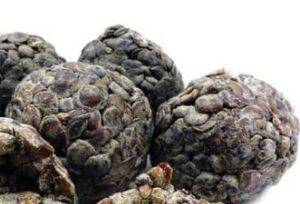Search Contents
How to Process Ogiri Egusi (Fermented Condiments from Melon Seeds)
This is how to make or process Ogiri Igbo with melon seeds or Egusi. You don’t need to bother again about where or how to get original ogiri Igbo prepared with melon seed.
There is a popular slang in Igbo dialect that says that “Ogiri bu Ogwu ofe“. When translated, it means, Ogiri is the most important medicine the soups need. This is means to say that, it is the ingredient needs for the soups to be delicious.
‘Condiments of Fermented Melon Seeds‘ or Fermented condiments from melon is the English name for Ogiri. Ogiri Egusi or Uri as people call it is an age-long condiment for local meals like Soup for Swallow like Ofe Ora, Bitter leaf soup, Nsala Soup, Ofe Ugu, etc. A typical home-grown Igbo lady knows that these meals mentioned are not complete if they are not prepared with Ogiri Igbo.
Click here to read how to cook Bitter leaf soup with Ogiri Igbo.
It is equally used by some people to prepare sauces for Ngwongwo, nkwobi, ngba ncha, abacha sauce, and ugba.
Melon seed is not the only seed used in processing Ogiri, Castor Oil, sesame seed known as Ugba or oil beans, and African Mesquites Seeds are among the seeds used in processing or producing Ogiri Igbo.
In this article, we shall concentrate on how to make Ogiri Egusi or Ogiri Anambra as many call it. You can read how to make or Process Ogiri Ugba (Condiments of Oil bean) here.
As a matter of fact, Ogiri that is made from melon seed is popular in the Eastern parts of Nigeria. It is even more popular among the people of Anambra.
If you want to read about the Healthy Way to Prepare Nkwobi and Ngwongwo, Click here.
How to Make or Process Ogiri Igbo with melon seeds or Egusi
Processing Ogiri melon Seeds or Ogiri Egusi are in 5 stages. We shall discuss them one after another.
This type of Ogiri is made with melon, purely melon, and no addition. In the typical native kitchen, unpeeled melon seeds are used in processing Ogiri.
-
Stage 1: Boiling the Melon Seeds
The unpeeled melon seeds are put in a large pot. Water is poured into the pot to the brim.
Note: Cooking melon seeds for Ogiri demands patience. It requires to be on the fire for about 12 hours.
The method varies anyway. But I learned from my grandmother that if the melon seeds are not cooked for the required time, it will affect the taste and appearance of the Ogiri when it is finally processed.
Normally, we used to Put Melon seeds on the fire in the evening. We will pour enough water and add enough firewood before going to bed.
The melon seeds would be on the fire till morning. This is the reason why I said it is cooked for about 12 hours. The 12 hours doesn’t necessarily mean the fire will be on two/four/7.
-
Stage 2: Peeling Stage
In the morning, work will begin. You will have to peel the lemon seed off the back. This time around the task has been made easier. The back of the seeds is softened.
You will have to pick two or three seeds at the same time, press them on the hard tray to burst open. When the seeds are burst open, you will just press on them with your fingers.
This is how you will do it until the last seed will be extracted. Then, you will get ready for the third stage.
How to Make or Process Ogiri Igbo with melon seeds or Egusi
-
Third Stage: Boiling the Melon Meat
Get a fresh leave, normally plantain leaves. Plantain leaves ideals for this work. Put the leaves above the surface of the fire and allow the heat of the fire to strengthen it. When this is done, the leaves will not tear when you are using them.
You can divide the extracted melon seeds, depending on the size of your melon seeds or your pot. Spread the leaves and pour the melon seeds inside. Use the leaves to wrap them and tie them round with a rope.
Make sure that the rope has gone round enough to prevent it from opening or pouring away. Get a fork or a pricking spoon and begin to prick the melon seeds wrap.
You are doing this to create openings so that water can penetrate into the melon. Also, the oil in the melon seeds needs to sieve out when it dries. These openings the places the oil will drip out.
Put it in the pot and pour a large quantity of water and make a fire. You will have to cook until the whole water is dry. When the water is dry, you will see brown and thick oil forming around the pot.
Keep making fire until there is no oil coming from the melon seeds wrap. By that time, your pot is giving the sign of burning.
Bring the pot down. You will need to keep the melon wrap to cool from the hotness of the fire. When it cool, you will get a sack bag or anything with a tight lid or cover and put it.
-
Stage 4: Fermentation and Pounding Stage
-

This is how fermented dried melon Seeds should look like when opened from the bulk wrapped
This is how fermented dried melon Seeds should look like when opened from the bulk wrapped
There is a number of days that are required for the melon seed to ferment or “ree” as the Igbos will call it. It needs to ‘reena ure”. I don’t mean to say getting rotten.
The word ‘ure’ in this contest means to ferment. For my granny, it is normally 4 market days. That is four days.
After these days, the melon wrap will be brought down from where she kept it on the kitchen local ceiling, under the fire. That is where the heat of the fire would be touching it.
You will need a pounder and a pestle. Open the wrap and pour all of them inside the mortar and begin to pound with a pestle.
At this stage, it doesn’t waste time or take time to pound. This is because the fire the days the melon seeds are kept to ferment has softened it beyond measure.
Just a little pound, here and there, you will have your Ogiri.

Did I say have your Ogiri? Yes. At that point, your Ogiri is good to go. But the likes of my grandmother and mother would not cook with it until it stays another more days and ferments more. That is when the smell becomes harder.
-
State 5: The Tying Stage
Unless you are producing for your personal consumption, you have to tie your Ogiri with paper. Even if it is for your family use, you will still need to put it in containers and allow it to ferment for a while before preserving it.
The Summary of how to Process Ogiri with Melon seeds
“Ogiri bu ogwu ofe“. Apart from knowing how to cook with it, you should also know how to process it. This is what we have done in this post
We just taught you how to process or make Ogiri with Melon seeds.
Note: There are also other methods of making Ogiri Egusi. What I thought is the method popular among Anambra people. The one they called Ogiri Egusi Anambra.
Click here to read how to know the difference between Ogiri Igbo Egusi and Ogiri Ugba.





